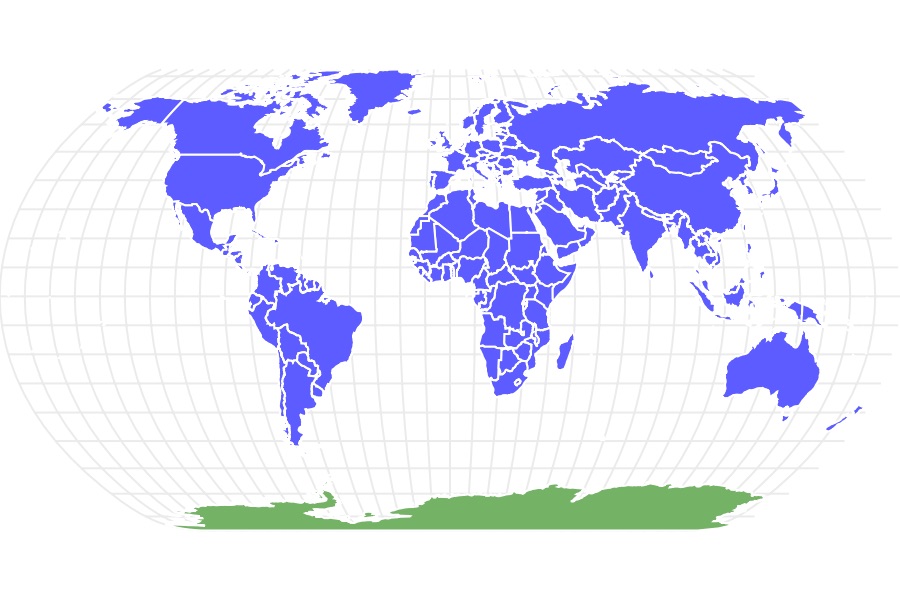Snail
Achatinoidea
There are more than 40,000 different species!
Advertisement
Snail Scientific Classification
- Kingdom
- Animalia
- Phylum
- Mollusca
- Class
- Gastropoda
- Order
- Achatinoidea
- Scientific Name
- Achatinoidea
Read our Complete Guide to Classification of Animals.
Snail Conservation Status
Snail Facts
- Average Litter Size
- 200
- Favorite Food
- Leaves
- Common Name
- Snail
- Number Of Species
- 1000
- Location
- Worldwide
- Slogan
- There are nearly 1,000 different species!
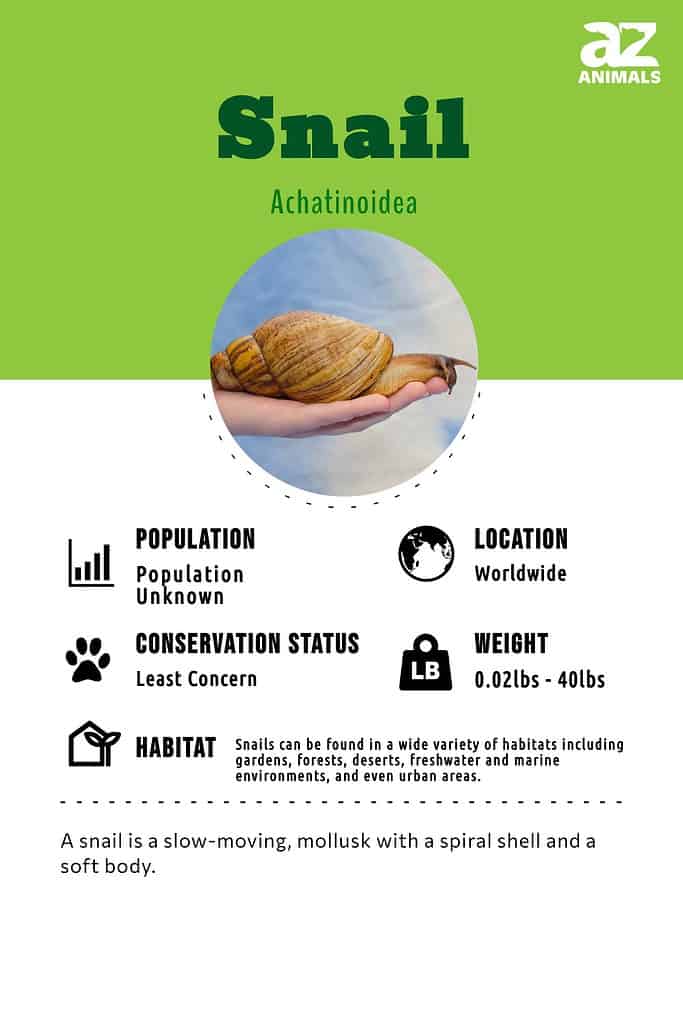
Slow-moving but always fascinating, the snail is one of the most ecologically diverse animals on the planet.
Belonging to the phylum of Mollusca, it’s found almost everywhere in the world, from high mountains to simple botanical gardens to deep undersea rocks. In some parts of the world, these animals are kept as pets. Check out these cool names for snails if you have one of these and you need a name for it.
The shell is the defining feature of the snail. This is the one thing that separates them from the closely related slugs and sea slugs (although many slugs still have internal shell plates within their bodies). Since the shells contain most of the internal organs, snails cannot survive without shells.
5 Incredible Snail Facts!
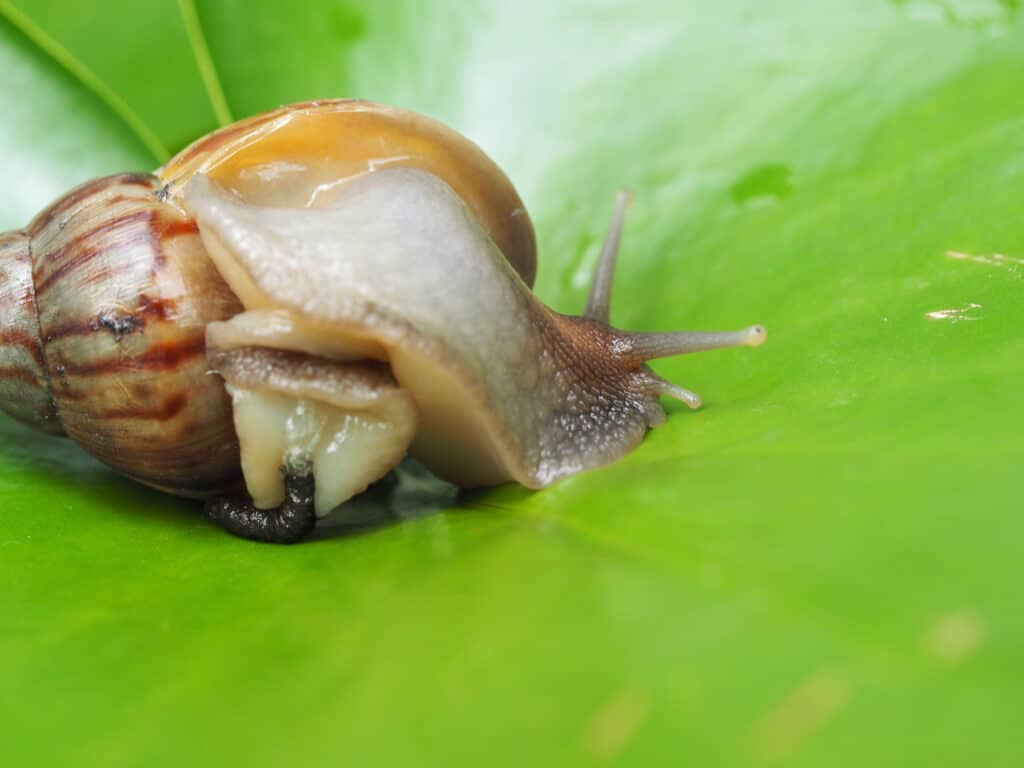
Snails poop, just like most creatures.
©Huaykwang/Shutterstock.com
- These animals contain only rudimentary eyes and no ears at all. Instead, they interact with the environment around them through their sense of touch and their ability to detect vibrations.
- One of the more unusual facts is that many species are hermaphroditic, meaning that they possess both male and female reproductive organs. After mating, snails bury their eggs below the ground. Depending on the climate conditions, these eggs will hatch a few weeks later. The young snails are so eager for food that they may consume the unhatched eggs from the same parents. During development, they undergo a process called torsion in which their mass is rotated to one side, meaning the anus is actually located close to the head.
- Snails can survive the harsh winter by living off their fat reserves. They have multiple lines of defense to protect their soft bodies as they hibernate: first, they dig a small hole in the ground, then they retreat into their shell, and finally, they seal off the entrance of the shell from potential predators. This process of hibernating is called estivation. It is also known as summer sleep but it is different from how snails sleep daily.
- Some aquatic snails (like the nerites) have gills to breathe underwater; others retain both lungs and gills. The apple snail has a breathing tube that reaches the surface of the water.
- The sea snail has a natural adhesive that allows them to stick to rocks without being carried away by the surf. This has inspired some researchers to develop a kind of experimental medical glue for use in repairing heart defects.
Evolution and Origins
The snail evolved on the planet over 150 million years ago. Gastropods, cephalopods, and bivalves were thought to represent a group of species that coexisted throughout the Cambrian epoch.
The earliest land snail is considered to have arisen around 350 million years ago when land plants first started to demand extremely moist circumstances. Being able to survive on land required the snail, whose body is still primarily made of water, to endure periods of unfavorable circumstances.
Furthermore, in shallow seas, the earliest snail species first appeared. This way of existence was made possible by gills, and many freshwater and saltwater animals still rely on them. The Late Cambrian Era, or roughly 500 million years ago, is when the earliest gastropods were unquestionably discovered.
Species, Types, and Scientific Names
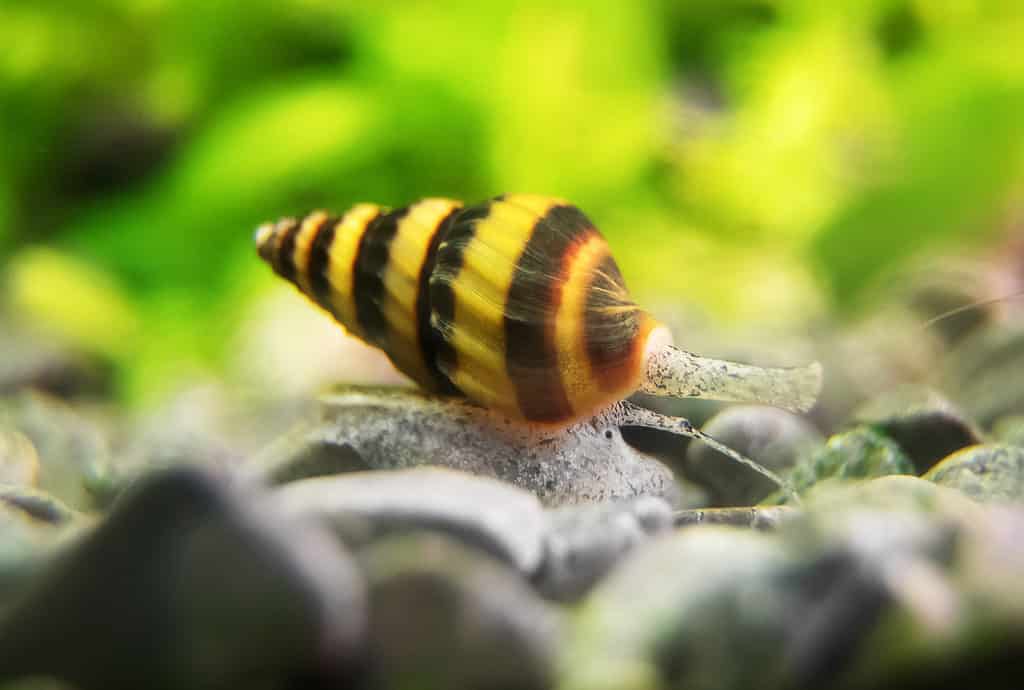
Assassin snail in aquarium.
©M-Production/Shutterstock.com
The scientific name of the snail is Gastropoda. This is derived from two Greek words meaning “stomach” and “foot.” The scientific name refers to the position of the foot below the gut. Gastropods belong to the phylum of Mollusca.
In terms of the number of species, they are the largest class within the phylum. About 24,000 species have so far been subject to classification, but there may be 85,000 or more species of gastropods in the world. These can be divided into a few general classifications:
- Land Snails – These are the most well-known and the most likely to interact with people. The majority of land snails fall within the sub-class of Heterobranchia, along with the slugs.
- Freshwater Snails – Represented by thousands of different species, including the apple snails and nerites, freshwater species primarily occupy rivers, lakes, and streams.
- Sea Snails – Elusive and rarely seen, most gastropods actually inhabit the deep seas and near coasts, an entire underwater world secluded from people. Sea snails are divided into a few different classifications such as the Vetigastropoda and Caenogastropoda.
Here are the most common, representative species of snail types:
- Garden snail
- Burgundy snail
- Monachoides vicinus
- Paralaoma servilis
- Neverita didyma
- Decollate snail
- Callistocypraea aurantium
- Cerithium echinatum
- Clypeomorus batillariaeformis
- Cerithium tenellum
- Cerithium scabridum
- Gastrocopta servilis
- Cerithium pacificum
- Cerithium africanum
- Cerithium browni
- Scutalus
- Cerithium acuticosta
- Cerithium atromarginatum
- Cerithium alutaceum
Appearance
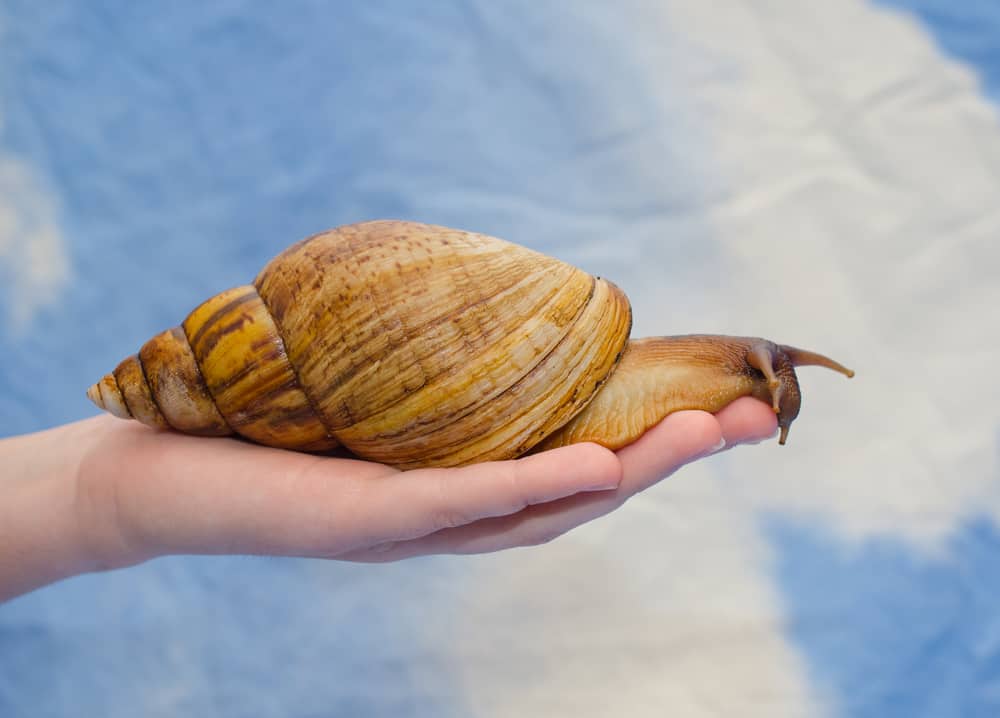
Giant African snail on a human hand (against a bright blue background)
©Olena Kurashova/Shutterstock.com
While most people are familiar with the basic garden snail, the entire gastropod class contains an immense diversity of different appearances and forms. Apple snails, nerites, ramshorn snails, etc all have their unique characteristics.
In terms of their diversity, gastropods are second only to the insect class. However, snails are not insects. Most snails possess a soft, tube-shaped body, a muscular foot for locomotion, one or more pairs of tentacles emerging from the head, and small eyes at the top of the base of the main stalks.
The most conspicuous feature that all species share is the spiral shell. It is attached directly to the body and cannot be removed without killing the snail, since it contains most of the internal organs.
The shell consists of three different layers attached to the mantle. The hypostracum is the innermost layer, situated directly against the body. The ostracum, which consists of calcium carbonate crystals and organic material, is the middle layer. The periostracum, which consists of several organic compounds, is the top layer and also gives the shell its color. Shells come in many different shapes, including cones, ears, spindles, and even completely unique patterns found nowhere else.
The largest known species is the Giant African Snail, which grows up to a foot long. The smallest ever species identified, which comes from southern China, is no more than a millimeter. Most species measure a few inches in size between these two extremes.
Is a Slug a Snail?
A slug isn’t a snail. Slugs are the closest animals that look like snails; however, both animals are not the same. Slugs are the only gastropods that live without shells at all. Their habitats and habits differ from snails. Since most slugs lack a shell, they tend to squeeze into tight places like under tree bark and rocks. These habitats help protect them from predators and are great places to lay eggs.
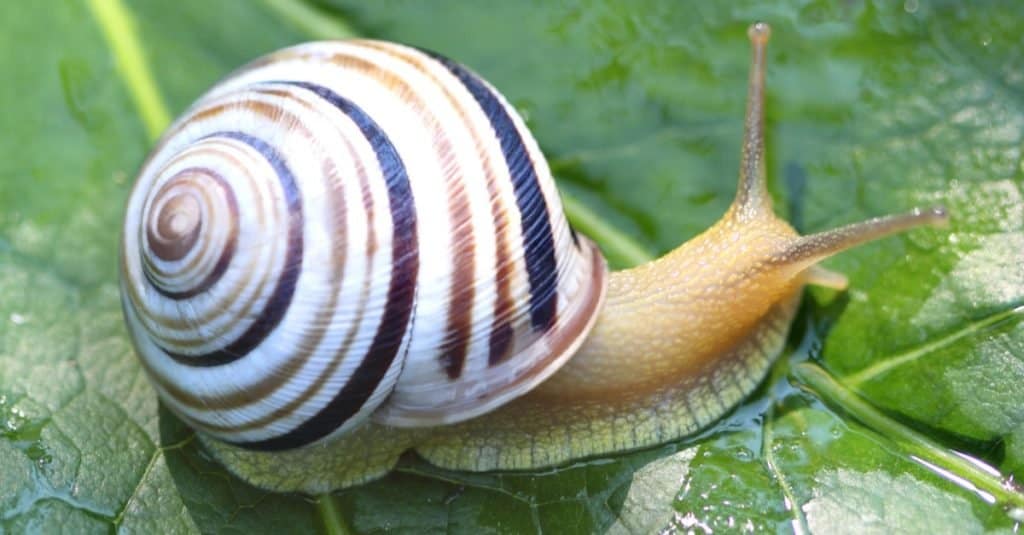
A beautiful multi-colored snail in the garden after the rains.
©bmaki/Shutterstock.com
Habitat
These animals are found almost everywhere on the planet, including oceans, rivers, lakes, forests, mountains, deserts, and even botanical gardens. The thickness of the shell is directly related to the local climate conditions. In drier regions, snails have thicker shells to help them retain moisture. In wetter regions, they tend to have thinner shells.
Diet
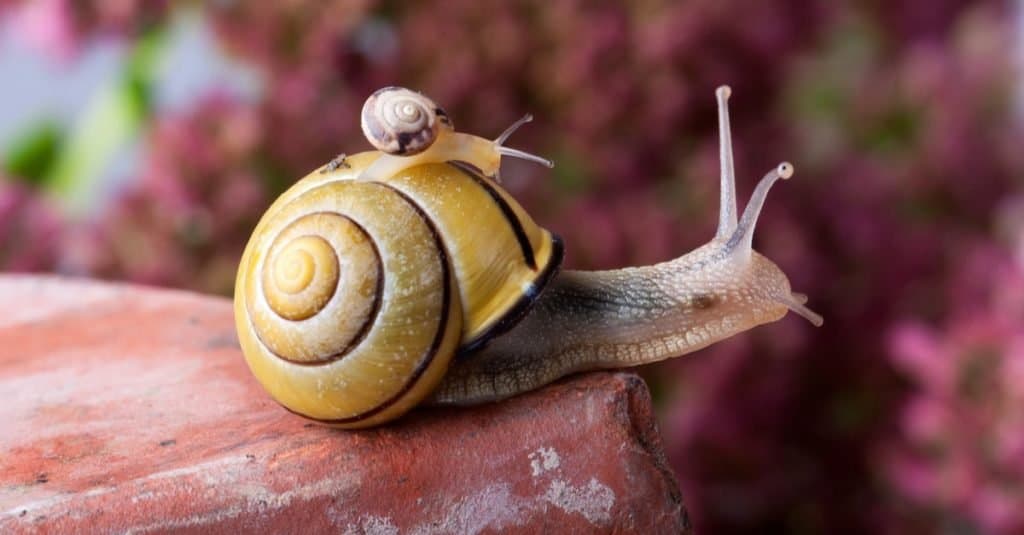
Closeup af a Yellow and Black banded Snail carrying a tiny snail on her back
©Nailia Schwarz/Shutterstock.com
One of the most interesting facts about the animal is the sheer diversity of different feeding strategies. Depending on the species, they run the gamut between an herbivorous, carnivorous, or even a parasitic lifestyle. Marine species are more likely to be carnivorous or omnivorous, while land snails tend to feast exclusively on plant matter. Most species have rows of small teeth and a rough tongue called a radula to consume food.
Garden snails eat mostly leaves, vegetables, and flowers. However, they may also eat organic matter like dead worms or even other snails.
What eats the snail?
The animal provides a stable food source for all kinds of hungry birds and mammals. It is also raised and eaten by humans across many different cultures and places. In France, for instance, the edible snail is considered to be a delicacy called escargot.
What does the snail eat?
Most of these animals are herbivorous; they feed on leaves, stems, bark, fruits, and even algae. Carnivorous snails (mostly of the marine variety) also happily consume worms, fish, and even other snails. These animals obtain calcium from dirt and rocks to build their impressive shells.
For a complete analysis of what snails eat, make sure to read ‘What Do Snails Eat? Their Diet Explained.‘
Prevention
For most people, these animals are simply an intrinsic part of the environment, easy to ignore. But anyone who’s ever tried to maintain a botanical lawn or garden knows that they sometimes cause immense damage to plants, especially since snails live up to 10 years in the wild! Short of calling a professional, there are several things you can do to get rid of them.
The most humane solution is to put up a copper mesh barrier to repel them or try to remove them by hand. You should also try to eliminate any dark, shaded areas which might attract snails. If you’re not invested in a specific type of plant, then you might want to consider using snail-resistant plants like lavender, rosemary, and sage. Salt is another effective method to get rid of snails, but it also might increase the salinity of the soil, which can damage plants.
Snails as Food
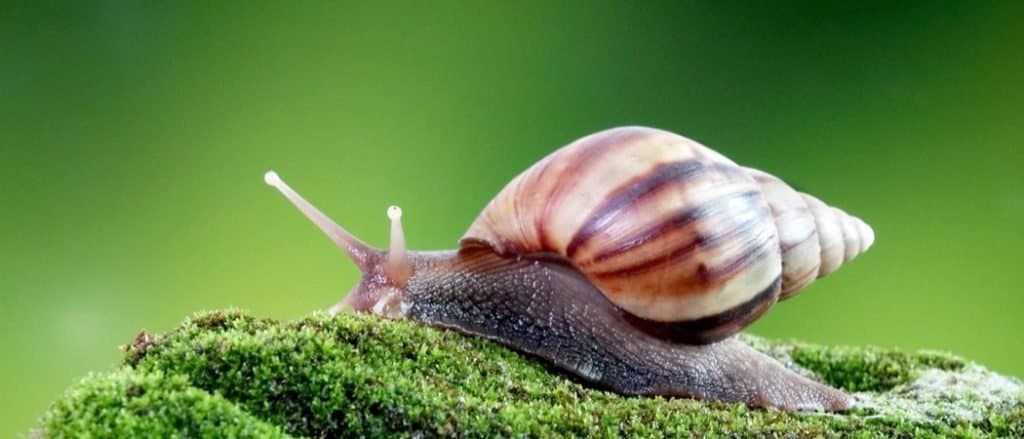
Giant African Land Snail
©Mark Brandon/Shutterstock.com
It is very common for humans to eat snails. In French cuisine, edible snails are served as a delicacy. The practice of raising snails for food is called heliciculture. Snails are often kept in a dark place in wire caged with dry wood or straw. Once ready, the snails are prepared for cooking. Once cooked, their texture becomes chewy yet tender.
Snails are often considered gourmet food and several different species of land snails can provide a hearty amount of protein to disadvantaged communities around the world. A variety of snails are valuable because they can feed a large number of people with little cost. In fact, in some countries, giant African land snails are produced commercially for food.
Land snails, freshwater snails, and even sea snails are all eaten in many countries. In some parts of the world, snails are fried as satay which is a dish called sate kakul. Even snail eggs of some snail species are eaten in a similar way caviar is eaten. Additionally, in Bulgaria, snails are cooked in an oven with rice or fried in a pan with vegetable oil.
View all 293 animals that start with SSnail FAQs (Frequently Asked Questions)
Are Snails herbivores, carnivores, or omnivores?
Depending on the species, snails run the gamut between an herbivorous, carnivorous, or even a parasitic lifestyle.
What Kingdom do Snails belong to?
Snails belong to the Kingdom Animalia.
What phylum to Snails belong to?
Snails belong to the phylum Mollusca.
What order do Snails belong to?
Snails belong to the order Achatinoidea.
What type of covering do Snails have?
Snails are covered in shells.
Where do Snails live?
Snails are found worldwide.
In what type of habitat do Snails live?
Snails live in well-vegetated areas.
What is the main prey for Snails?
Snails eat leaves, fruits, and stems.
What are some predators of Snails?
Predators of Snails include rodents, frogs, and birds.
What are some distinguishing features of Snails?
Snails have armored shells with long, thin eye stems.
How many babies do Snails have?
The average number of babies a Snail has is 200.
What is an interesting fact about Snails?
There are nearly 1,000 different species of Snail!
What is the scientific name for the Snail?
The scientific name for the Snail is Achatinoidea.
How many species of Snail are there?
There are 1,000 species of Snail.
Are snails dangerous?
The vast majority of snails are completely harmless. But there is one marine group called the cone snails that can inject dangerous venom into anything that threatens it. The smallest cone snails aren’t too dangerous; they only deliver a painful sting like a bee. But the largest species can actually kill a person with their potent venom. Fortunately, these species are not usually encountered by people.
How many legs does the snail have?
Snails possess a single muscular foot and not a leg. By making a wavy motion with this foot, they can push against a surface to move forward.
How do you identify snails?
Snails are easy to identify from their long, tube-like bodies, sinewy tentacles, and the spiral shell on the back. In fact, most true snails cannot live without shells.
How do you get rid of snails?
Some of the best strategies to get rid of snails include setting traps and barriers, removing them by hand, using drip irrigation methods on your plants, replacing your current plants with snail-resistant ones, and eliminating all potential hiding places. Salt can also work to repel them.
How can snails kill you?
A few species of marine cone snail can inject dangerous venom via a harpoon-like apparatus (essentially, a modified tooth), but only a few dozen deaths have ever been recorded from cone snails.
Can a snail see?
A snail can sense basic lightness and darkness with its eyes but not much more.
How long does a snail live?
Most species only live for a few years, but some of the larger snails may live up to 10 years in the wild.
Do snails have teeth?
Yes, they have rows of small teeth in their mouths.
Do snails make good pets?
Snails can make good low-maintenance pets for anyone invested in their care, but owners will need to simulate their natural environment as much as possible. They’re also short-lived even by the standards of most pets.
What are the key differences between nerite snails and mystery snails?
The key differences between nerite snails and mystery snails are taxonomy, size, color, health issues, and lifespan.
What are the differences between male and female mystery snails?
The differences between male and female mystery snails are physical characteristics, behavior, and shell color.
What are the key differences between apple snails and mystery snails?
The key differences between apple snails and mystery snails are taxonomy, appearance, and diet.
What are the key differences between Trochus snails and Astrea snails?
The key differences between Trochus snails and Astrea snails are appearance, reproduction, and lifespan.
What are the key differences between pond snails and bladder snails?
The key differences between pond snails and bladder snails are appearance, lifespan, and adaptability.
Thank you for reading! Have some feedback for us? Contact the AZ Animals editorial team.
Sources
- Thought Co, Available here: https://www.thoughtco.com/guide-to-terrestrial-snails-130415
- Lloyd Pest Control, Available here: https://www.lloydpest.com/blog/how-to-get-rid-of-snails/
- Mentalfloss, Available here: https://www.mentalfloss.com/article/69003/16-surprisingly-fast-facts-about-snails

